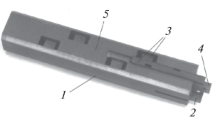Abstract
Buried light edge-emitting diodes (LEDs) with a wide emission spectrum in the wavelength range of 1380–1420 nm were developed. The design of an edge LED with a channel in a substrate and with the crescent active region and blocking layers of InP/GaInAsP/p-n-p-n/ZnSe was presented. Coupling of LED with an optical single-mode fiber and a microlens on the end of an optical fiber was performed. The characteristics of LEDs based on mesa-stripe heterostructures InP/GaInAsP were investigated. The dependences of the output power and the LED emission spectra based on mesa-stripe heterostructures InP/InGaAsP/InP with the crescent active region and p-n-p-n/ZnSe structure blocking the leakage current on the stabilization temperature of the active element and the injection current were studied. The dependence of the output parameters on the emitter stabilization temperature was demonstrated, which enables the creation of devices based on such LEDs both with and without forced cooling. The opportunity to develop buried LEDs with the crescent active region and a low degree of emission spectrum modulation was shown. The possibility of the entry of up to 45% of the LED radiation into a single-mode optical fiber using microlenses produced by chemical etching and fusion of a fiber end in a high-voltage arc of a welding machine was demonstrated.
Similar content being viewed by others
References
Ostermayer, F.W., Jr., Kohl, P.A., and Burton, R.H., Photoelectrochemical etching of integral lenses on GaInPAs/InP light-emitting diodes, Appl. Phys. Lett., 1983, vol. 43, pp. 642–644.
Burrus, C.A. and Miller, B.I., Small-area double heterostructure AlGaAs electroluminescent diode sources for optical fiber transmission lines, Opt. Commun., 1971, vol. 4, p. 307–309.
Maksimov, A.D., Eistrikh-Geller, V.Yu., Marmalyuk, A.A., Ladugin, M.A., Bagaev, T.A., Gorlachuk, P.V., and Yarotskaya, I.V., A model for calculating the composition of GaAsxP1–x solid solutions under metalorganic vapor phase epitaxy conditions, Inorg. Mater., 2017, vol. 53, no. 4, pp. 369–375.
Korkishko, Yu.N., Fedorov, V.A., Prilutskii, V.E., Ponomarev, V.G., Morev, I.V., and Kostritskii, S.M., Interferometric closed-loop fiber-optic gyroscopes, Proc. SPIE, 2012, vol. 8351, pp. 83513L-1–83513L-8.
Miya, T., Terunuma, Y., Hosaka, T., and Miyashita, T., Ultimate low-loss single-mode fibre at 1.55 μm, Electron. Lett., 1979, vol. 15, pp. 106–108.
Svirin, A.V., Kiiko, Yu.I., Obruch, B.V., and Bogomolov, A.V., Spectral optical coherent tomography: principles and possibilities, Klin. Oftal’mol., 2009, no. 2, p. 50–53.
Genei, K., Tanioka, A., Suhara, H., and Chinen, K., High coupled power 1.3 μm edge-emitting light-emitting diode with a rear window and an integrated absorber, Appl. Phys. Lett., 1988, vol. 53, no. 13, pp. 1138–1140.
Nagai, H., Noguchi, Y., and Sudo, S., High-power, high efficiency 1.3 μm superluminescent diode with a buried bent absorbing guide structure, Appl. Phys. Lett., 1989, vol. 54, no. 18, pp. 1719–1721.
Kashima, Y., Kobayashi, M., and Takano, H., High output power GaInAsP/InP superluminescent diode at 1.3 μm, Electron. Lett., 1988, vol. 24, no. 24, pp. 1507–1508.
Vasil’ev, M.G., Vasil’ev, A.M., Kostin, Yu.O., Shelyakin, A.A. and Izotov, A.D., Buried crescent InP/InGaAsP/InP on p-InP for linear edge-emitting diodes, Inorg. Mater., 2017, vol. 53, no. 11, pp. 1170–1173.
Vasil’ev, M.G., Vasil’ev, A.M., and Shelyakin, A.A., Planar buried crescent InP/InGaAsP/InP heterostructure on p-InP, Inorg. Mater., 2008, vol. 44, no. 9, pp. 913–917.
Vasil’ev, M.G., Vasil’ev, A.M., Golovanov, V.V., Izotov, A.D., and Shelyakin, A.A., Method for stepped etching of optical glass fibers, Russ. J. Inorg. Chem., 2016, vol. 61, no. 9, pp. 1160–1162.
Casey, H.C.P., Jr. and Panish, M.B., Heterostructure Lasers, Part A: Fundamental Principles, New York: Academic, 1978.
Author information
Authors and Affiliations
Corresponding author
Additional information
Original Russian Text © M.G. Vasil’ev, A.M. Vasil’ev, Yu.O. Kostin, A.A. Shelyakin, A.D. Izotov, 2018, published in Perspektivnye Materialy, 2018, No. 5, pp. 17–22.
Rights and permissions
About this article
Cite this article
Vasil’ev, M.G., Vasil’ev, A.M., Kostin, Y.O. et al. Study of Linear Light Edge-Emitting Diodes Based on InP/InGaAsP/InP Heterostructure with the Crescent Active Region. Inorg. Mater. Appl. Res. 9, 813–816 (2018). https://doi.org/10.1134/S2075113318050295
Received:
Published:
Issue Date:
DOI: https://doi.org/10.1134/S2075113318050295



